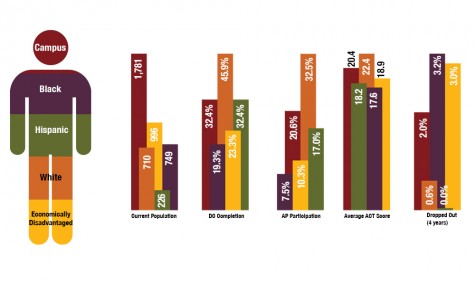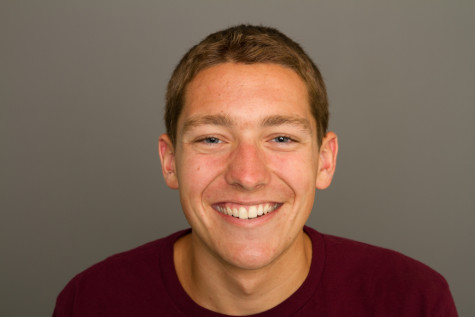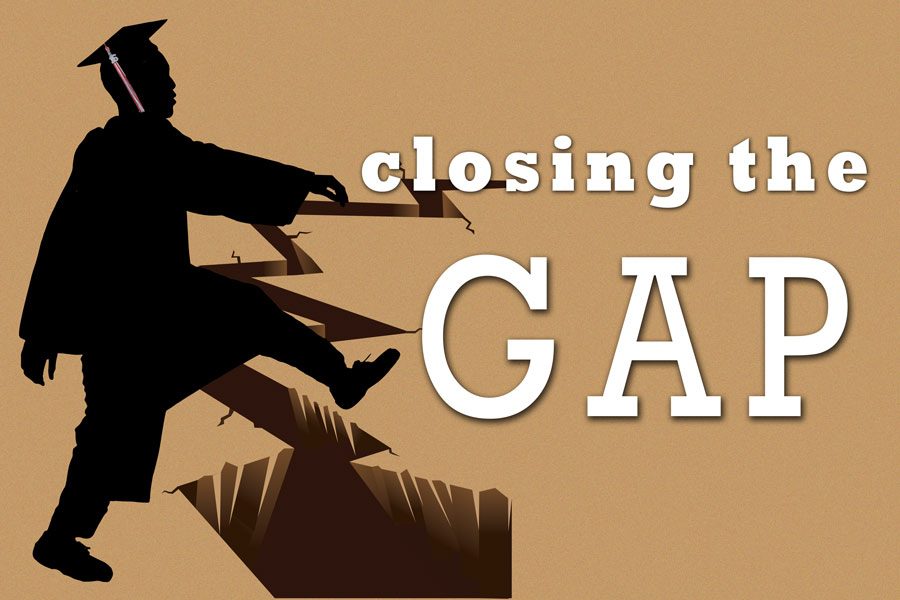The great divide
Performance gap is biggest challenge for school
Photo by Rachel Lewis
Numbers never lie. There is a divide in performance. Schools struggle with making sure each student is prepared to pass their exams, but it’s not enough. Something must be done to close the separation between haves and have nots in education.
The alarm clock rings. He lazily climbs out of the bed, puts on some clothes and trudges to school. The bell rings, and it’s test day. But he didn’t study. He doesn’t care. He just wants to take the test and go back to bed.
The alarm clock rings. She pulls herself out of the bed, puts on some clothes and rehearses strategies for the test as she makes her way to school. The bell rings, and it’s test day. She did study. She does care. She is ready to make an A.
One student failed. The other passed with flying colors. One student repeats this for other classes. The other is active, alert and ready to pass each exam. This difference between students passing their exams is commonly referred to as the performance or achievement gap.
The only area that Texas High School did not receive a distinction was in closing the achievement gap in a report produced by the Texas Education Agency each year. The school finished 23 out of 41 schools. In order to receive distinction, schools must place in the top 10 in the state.
“It’s the toughest one that we have had to face, and there are different factors involved in why we haven’t done it,” principal Brad Bailey said. “It’s been a little bit slower, but it could be due to gaps in learning from earlier years. [Students] get so ahead as [they] advance in grades that it overwhelms [them.]”
A peer mentoring program has been instituted by the school in order to help students who are struggling to understand class material. This was previously attempted with outside teachers and experts in the field, but did not receive the results administration was looking for.
Instead, administration turned to staff located on the campus and had students come in for tutorials during the teacher’s conference period. The REACH program is also a small group of students that work together to understand concepts they originally did not comprehend to help close the achievement gap.
“It’s not necessarily the same thing [students] get in the classroom,” Bailey said. “It’s more hands-on, very targeted instruction where it is one on one.”
Advanced Placement/Dual Credit classes
Peering inside the classroom, an outsider sees a class with a high level of white students and no or low amount of minorities. Recently, the AP Ambassadors program was started to reverse this trend and is directed by Coordinator for Academic Advancement Charlotte Leon.
“We are trying to help promote and encourage [the] subpopulations to be involved in AP and DC classes to help them reflect closer to our demographics,” Leon said. “They can prove it to their parents or get that step ahead. That is what we are trying to do.”
AP Ambassadors include high achieving minority students that Leon hopes will connect to other students better than she can. Leon is bringing Ambassadors into classes that are making their choice sheet selections for next year.
“[Students] perked up when [an ambassador] went in the class. They listened. They asked her questions,” Leon said. “You could kind of see in their faces ‘I can do that too.’ It just registered.”
Some students however choose not to be in advanced classes because of a dislike of the teaching styles.
“The teachers seemed to try to make it hard that way once you get to college it will seem easier, but it wasn’t really [them] teaching,” junior Keyondra Gamble said. “It was just [them] giving a bunch of work and not really giving a lesson, so it made it difficult for me, and I had to get out of the class.”
In order to solve the teacher problem, Bailey says they are attending instructional training sessions and offering training to the teachers over how to solve the gap in performance.
“We’ve been attending training over instructional strategies that will target those areas of improvement that we need to look at,” Bailey said. “We are working on better instructional strategies to help target the needs of our students.”

Economic/Social
In a school that is classified as a low-income school, 55.9 percent of the students were classified as economically disadvantaged for the 2013-2014 school year. The free and reduced lunch program is also used as a way to lower the cost of AP tests, bringing the cost from $90 to $7 along with two free tests. However, some students won’t encounter the economic problem at school but will meet it at home.
“I wouldn’t be able to get internet connection at home,” junior Marques Alexander said. “The timing would also be different because I wouldn’t get home in time to do most homework projects.”
For some who choose regular classes over advanced ones see it more as a social issue rather than an economic one.
“There aren’t a lot of minorities in [advanced classes,]” Gamble said. “There aren’t a lot of black kids in there. I guess it’s because you don’t look cool being in an advanced class.”
Social stereotypes include a student’s drive to succeed, and Bailey says that this can only be combated from within each student.
“We can put a lot of responsibility on ourselves as administration and as a campus, but our students have to be motivated to accept help and want to get better,” Bailey said. “We’ve got to continue to motivate, continue to encourage, try to make class interesting and try to catch them up as best we can.”
Grades are not the only use of motivation for students. Some choose not to participate in advanced, harder, more pressured classes because they want to participate in their favorite clubs or sports.
“I felt like I wouldn’t meet the standards to play football,” Alexander said. “I wanted to have a good grade, but [AP classes] are harder and have more pressure.”
While students are struggling to pass harder classes, overcome social stigmas, and economic barriers, administration is working to find a clear cut, foolproof program to accomplish the daunting task of closing the achievement gap.
“We are not giving up by any means,” Bailey said. “If anyone has any suggestions to make, I am always willing to take them. We are continuously working on that and going to keep trying.”

Tyler Snell is a third-year newspaper staff member and a senior at Texas High. He is the current print co-editor-in-chief with star-crossed lover, Anna...



